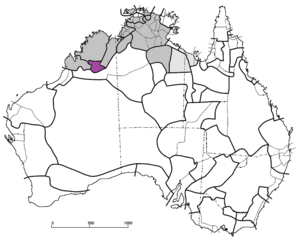Bunuban languages facts for kids
Quick facts for kids Bunuban |
|
|---|---|
| Geographic distribution: |
around Fitzroy Crossing, Kimberley region |
| Linguistic classification: | One of the world's primary language families |
| Subdivisions: | |
 Bunuban languages (purple), among other non-Pama-Nyungan languages (grey)
|
|
The Bunuban languages (also called Bunaban) are a small group of Australian Aboriginal languages. They are spoken in the northern part of Australia, especially around Fitzroy Crossing in the Kimberley region.
This language family has two main languages: Bunuba and Gooniyandi. These two languages are related to each other in a similar way that English is related to Dutch.
Bunuba has about 100 people who speak it, and Gooniyandi has around 400 speakers. Both of these languages are considered endangered. This means that not many people speak them anymore, and there is a risk they could disappear if efforts are not made to keep them alive.
Contents
What is a Language Family?
A language family is a group of languages that all came from a single, older language. Think of it like a family tree! All the languages in a family share some common features, like similar words or grammar rules, because they have a shared ancestor. The Bunuban languages are a small family within the larger group of Indigenous Australian languages.
The Bunuban Languages
The two languages in the Bunuban family are Bunuba and Gooniyandi. They are important parts of the culture and history of the Aboriginal people in the Kimberley region.
- Bunuba is spoken by the Bunuba people. It has about 100 speakers, making it an endangered language.
- Gooniyandi is spoken by the Gooniyandi people. It has more speakers, around 400, but it is also considered endangered.
When a language is endangered, it means that fewer and fewer people are learning and speaking it. This can happen for many reasons, like younger generations learning other languages instead. It's important to try and preserve these languages because they carry unique stories, knowledge, and ways of understanding the world.
Words in Bunuban Languages
Languages often share some words, especially if they are from the same family. Here are some basic words in Bunuba and Gooniyandi. You can see how some words are similar, and some are quite different!
| English | Bunuba | Gooniyandi |
|---|---|---|
| man | gujɽäma | juwulu |
| woman | wiːji | maŋo |
| head | guŋgulu | walu |
| eye | mulu | mɔːlu |
| nose | wuɽa | manili |
| mouth | djäläṉ | daŋandi |
| tongue | djälän | djäläṉ |
| stomach | giniŋa | djulu |
| bone | gudju | gudji |
| blood | gili | wari |
| kangaroo | wandjiri | wandjiri |
| opossum | läŋgur | djämbidjin |
| emu | ganaŋandja | |
| crow | waŋgaɳa | waŋgide |
| fly | ŋirinji | ŋurinj |
| sun | gawara | miri |
| moon | gilimana | djaːlin |
| fire | windäli | weandi |
| smoke | bindja | wangi |
| water | gaɽwa | gaːmba |
Where are they Spoken?
The Bunuban languages are spoken in the Kimberley region of Western Australia. This area is known for its amazing landscapes, including deep gorges, rivers, and unique wildlife. It is also home to many different Aboriginal communities, each with their own rich culture and languages. Fitzroy Crossing is a town in this region, and it's a central place for the communities who speak Bunuba and Gooniyandi.
Why are these Languages Important?
Every language is a treasure! Indigenous languages like Bunuba and Gooniyandi are not just ways of talking; they carry the history, stories, traditions, and knowledge of generations. They connect people to their land and their ancestors. When a language is lost, a whole way of seeing the world can be lost with it. That's why many people are working hard to record, teach, and keep these important languages alive for future generations.
See also
 In Spanish: Lenguas bunubanas para niños
In Spanish: Lenguas bunubanas para niños

